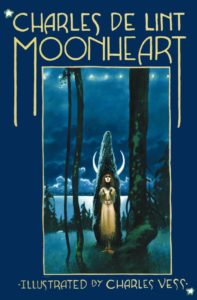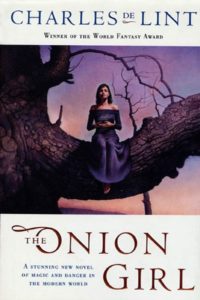(This is part two of three on the genesis of Urban Fantasy and the colonization of the cities by the fantastic. Part 1 covered Emma Bull and her seminal novel, The War for the Oaks.)
Urban fantasy is a melting pot of myths and mythology applied in a (mostly) modern, urban setting. The first main town to erupt on the map was Charles de Lint’s Newford, a northwestern city drawing power from the landscape of fog and rain, with underlying scents of both the ubiquitous coffee shop and the wildness of indigenous legends.
 Moonheart, published in 1984, is the first novel set in Newford. Subsequent short stories, collections and other novels would use the setting and landmarks of this fictional city bearing a strong resemblance to Ottawa. In Newford, if you squint your eyes just right, or leap around a corner in the shadow of a streetlight, you’ll find the fair folk. Crow girls dance in the twilight notes of a street guitarist. Magic is all around you in Newford, if you just know how to look at life in the right way.
Moonheart, published in 1984, is the first novel set in Newford. Subsequent short stories, collections and other novels would use the setting and landmarks of this fictional city bearing a strong resemblance to Ottawa. In Newford, if you squint your eyes just right, or leap around a corner in the shadow of a streetlight, you’ll find the fair folk. Crow girls dance in the twilight notes of a street guitarist. Magic is all around you in Newford, if you just know how to look at life in the right way.
Books set in Newford include Dreams Underfoot, Memory and Dream, The Ivory and the Horn, Trader, Someplace to Be Flying, Moonlight and Vines, Forests of the Heart, The Onion Girl, Tapping the Dream Tree, Spirits in the Wires, Widdershins, Promises to Keep, Muse and Reverie, The Dreaming Place, and Little (Grrl) Lost, among others.
In Moonheart, a niece (Sara Kendall) and her uncle (Jamie Tamson), antique dealers, come into possession of an unusual ring, one which various forces wish to obtain. The urbanity of the city is revealed to have an underpinning of magic, of the fantastic, and both are drawn into an age old conflict. Moonheart also introduces one of de Lint’s linchpin characters, Jilly Coppercorn, a former street kid with a link to the unseen world around us. Jilly Coppercorn exists in many of the Newford stories. The first novel centering on her was The Onion Girl, published in 2001.
Jilly Coppercorn is therefore one of the first urban fantasy heroines and exemplifies characteristics that would go on to define the genre. Her past is terrifying, filled with abuse and rape, which she has overcome, and despite the grimness, she is cheerful about the present and future. She is almost relentlessly optimistic and this characteristic, along with her ability to see the best in almost everyone, leads her to become friends with the Seelie court, among others. Her sunshiny viewpoint is infectious.
The power of de Lint lies not only in his ability to create believable, strong, urban females, but, more importantly, in how he writes his men.
It’s not enough to write strong women characters, if their love interests and allies are toxic men.
It is not enough to have only the women represent. Men must stand up as well.
Despite the advantage of privilege, the patriarchy is damaging to men. The “alpha” male characteristics valued under that society lead to repression and damage everyone. Emotion is bad. Sensitivity is weak. Artistic natures are signs of deviance – in fact, any expression of anything remotely related to a “feminine” characteristic is ridiculed and bullied. Authoritarianism and aggression are valued over democracy and inclusion.
Thus, Charles de Lint’s villains are almost always men who exemplify the strengths valued in a patriarchal society. They believe they have “rights,” particularly over women, but also over anyone that represents as other.
 Take for example, Jilly’s older brother Del, who rapes Jilly repeatedly, until she escapes to live a life on the streets, or Robert Carson, who pimps Jilly out and gets her hooked on drugs. These are villains who are toxic and male.
Take for example, Jilly’s older brother Del, who rapes Jilly repeatedly, until she escapes to live a life on the streets, or Robert Carson, who pimps Jilly out and gets her hooked on drugs. These are villains who are toxic and male.
Fortunately, for both Jilly and us, Charlie de Lint also subverted the male hero. His men take “weak” characteristics, such as artistic nature (musical ability), or empathy and use them as their strength. They allow these qualities to be a source rather than a hindrance. His men are allies and represent the characteristics of understanding and respect. They recognize inherent privilege and labor to defeat hate, they’re there when needed, can be relied upon, and are aware of intersections. And they’re still sexy, proving sexiness does not have to be a toxic characteristic.
Examples include Toby Childers, who helps Jilly in her quest, or friend Joe Crazy Dog, a shapeshifter and ally. Newford abounds with these “newfound” men – ones who reject a culture of toxic masculinity, use empathy and understanding as a strength, and are willing to stand up and give aid and comfort (when asked or needed) to those in distress.
For the map, Newford as a genesis city set a pathway that would lead others into newfound traditions of what it means to be masculine, feminine, or other. The city of Newford inspires all.

I’m surprised. I must have missed Jilly’s appearance in Moonheart. She’d fit right in at Tamson House, though. Thanks for this post!
Moonheart is explicitly set in Ottawa. It’s not the first Newford book. Are you meshing two de Lint books together?
It is set in Ottawa, but is the prototype and becomes Newford.